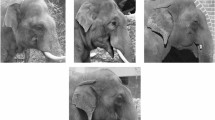Abstract
Black-tailed deer (Odocoileus hemionus columbianus) discriminate between the geometric isomers of a lactone used as a pheromone by the species. They react strongly to (Z)-4-hydroxy-6-dodeceonic acid lactone, which occurs in their tarsal scent, but the response to theE isomer did not differ from the response to the solvent. The isomers were applied to one member of a group of freely interacting deer, and the sniffing, licking, and following responses were recorded. The synthesis of the geometric isomers of the lactone is described.
Similar content being viewed by others
References
Affrossman, S., andThomson, S.J. 1962. Selective poisoning of the catalyst in the Rosenmund reaction.J. Chem. Soc. 2024.
Brownlee, R.G., Silverstein, R.M., Müller-Schwarze, D., andSinger, A.G. 1969. Isolation, identification and function of the chief component of the male tarsal scent in black-tailed deer.Nature 221:284, 285.
Elvidge, J.A.,Linstead, R.P.,Orkin, B.A.,Sims, P.,Baer, H., andPattison, D.B. 1950. Unsaturated lactones and related substances. Part IV. Lactonic products derived from muconic acid.J. Chem. Soc. 2228.
Hauser, C.F., Brooks, T.W., Miles, M.L., Raymond, M.A., andButler, G.B. 1963. The Wittig synthesis. I. Use of certain aliphatic aldehydes as intermediates in the synthesis of olefins.J. Org. Chem. 28:372.
Klun, J.A., Chapman, O.L., Mattes, K.C., Woitowski, P.W., Beroza, M., andSonnet, P.E. 1973. Insect sex pheromones: Minor amount of opposite geometrical isomer critical to attraction.Science 181:661, 662.
Morrison, D.F. 1967. Multivariate Statistical Methods. McGraw-Hill, New York.
Müller-Schwarze, D. 1967. Social odors in young mule deer.Am. Zool. 7:807.
Müller-Schwarze, D. 1969. Complexity and specificity in a mammalian pheromone.Nature 223:525, 526.
Müller-Schwarze, D. 1971. Pheromones in black-tailed deer.Anim. Behav. 19:141–152.
Müller-Schwarze, D., andMüller-Schwarze, C. 1975. Subspecies specificity of response to a mammalian social odor.J. Chem. Ecol. 1:125–131.
Silverstein, R.M., andYoung, J.C. 1976. Insects generally use multicomponent pheromones,in M. Beroza (ed.), Prospects for Insect Pest Management with Sex Attractants and Other Behavior-Controlling Chemicals. American Chemical Society, Washington. ACS Symposium Series 23:1–29.
Wessely, F., Siegel, A., andStockhammer, P. 1957. Die Einwirkung von wässerigem Alkalihydroxyd aufo-chinolacetat. Festschr. Arthur Stoll, 434.Chem. Abstr. 53 6142d (1959).
Author information
Authors and Affiliations
Rights and permissions
About this article
Cite this article
Müller-Schwarze, D., Silverstein, R.M., Müller-Schwarze, C. et al. Response to a mammalian pheromone and its geometric isomer. J Chem Ecol 2, 389–398 (1976). https://doi.org/10.1007/BF00988284
Received:
Revised:
Issue Date:
DOI: https://doi.org/10.1007/BF00988284




